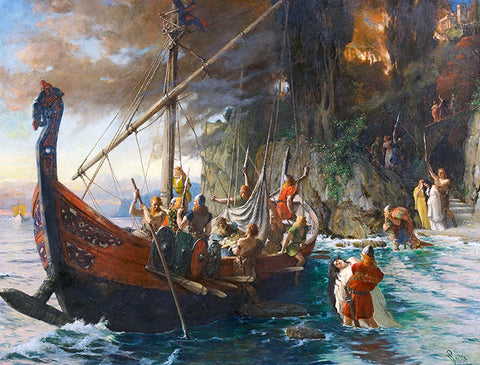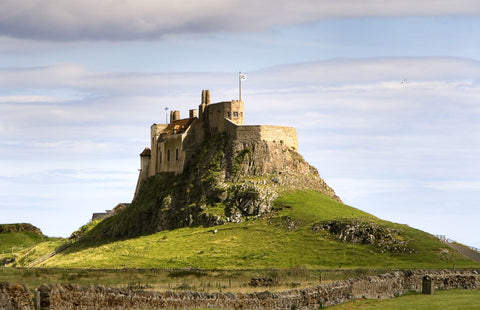Jewels in the Middle Ages: the Vikings
When we talk about Vikings we refer to men and women from Scandinavia who, between the end of the eighth and the beginning of the eleventh century, raided and traded in many areas of the Western world, but also of the East.
On board their ships, the Drakkars , the Vikings left for numerous destinations: in Europe they arrived on the British Isles, in France, in the Shetland Islands, in the Orkney Islands, in the Faroe Islands , in Iceland, and in many other kingdoms. of the European world; but they also went further east, as far as Russia and Constantinople, as well as further south, reaching as far as Africa. But the most surprising journey they took was the one that took them to the shores of America, in Newfoundland.

Image 1: Ferdinand Leeke, "Viking Raid", 1901
As we know, jewels are made of metals such as bronze, silver, gold, gems and precious stones, but also of simpler materials, such as wood or glass.
The Vikings, by raiding and trading, had a vastness of possibilities to come into possession of these raw materials, therefore useful, as well as for other events, for the production of jewels.
The Scandinavians were able to use these goods for the production of precious jewelry and luxury goods both in the settlements created outside Scandinavia (especially in the British Isles), but also in the motherland.
To understand the importance of these events for the production of Viking jewels, just think of the countless raids that the Vikings organized and made in the monasteries of the European world which, while apparently uninterested in these raiders, were actually home to great treasures of the religious world. One of the first and most famous of these raids is the one that took place on June 8, 793 AD, in the English abbey of Lindisfarne, which is located on the island of the same name: here the Vikings gathered a nice booty, including religious artifacts in gold, silver and other precious metals and stones.
The looting was obviously also committed against entire cities, such as the one that took place in Nantes in June 843, which allowed the attackers to grab some tasty spoils.
But these men and women were able to get rich and own raw materials and precious metals even through less violent and more legal methods: we are talking about commercial activities, in which, as mentioned, the Vikings were particularly skilled and skilled, thanks to their skills. navigation, which brought them to the most flourishing and richest markets in the world (such as the eastern ones), but also thanks to the trading bases present in the motherland. 
Image 2: View of the monastery of Lindisfarne, located on the homonymous island
Another important feature to highlight, typical of the Viking world, is that concerning the religious history of these people: it is clear that even in the jewels we see a representation and a testimony of the religion of this people, the Norse one, thus finding numerous symbols and images of their gods and everything that belonged to their world; but, during the eleventh century, a definitive process of assimilation to the Christian religion of the entire Scandinavian universe began, which therefore had important consequences also on the appearance of their jewels: from this moment on, in fact, Christian elements began to appear more and more, gradually replacing the pagan ones.
Most of the Viking era jewels come from archaeological sources: excavations of city sites, shopping centers in the Scandinavian world, random finds of Viking objects in other areas of the world or objects re-emerged from the water, but above all the findings made in the tombs, they are our most important sources for this type of finds.
The production of these objects was mainly based on more durable materials, such as metals (precious and otherwise), amber, glass, but also wood, ivory (in this case coming from walrus tusks) and bones.
Wood was undoubtedly the raw material of choice for Viking artists, being relatively easy to carve, cheap and also abundant in northern Europe.
As for the metal, this is the material of which most of the jewelry that has been found is made, therefore the studies are mainly based on this type of material.
The materials mainly used for Viking jewels were however bronze or silver, the latter sometimes gilded; however, important and sumptuous jewels were also found entirely in gold, in single pieces or in sets, probably belonging to the richest and most important figures in the Scandinavian world.

Image 3: Gold buckles
The jewels were worn by both men and women, of all social strata; they wore brooches, necklaces, rings, bracelets and necklaces. These objects obviously had an ornamental and practical function (such as brooches, which were used to stop clothes), but they could also indicate the state of well-being of these people. In addition, there were some pieces that had a particular symbolic value, such as all those jewels that bore a religious representation (more immediate example the hammer of Thor).
As mentioned, the jewels were used by both men and women, although there were some differences, in the type of jewels but also in the styles.
Married women tied their surcoats close to the shoulders with a pair of large matching brooches (modern scholars today call these brooches "tortoiseshell brooches", due to their domed shape). The shape and style of these particular brooches varied from region to region, but many artisans used the fretwork. Between these two brooches, very often, women strung chains or strings of beads, or hanging ornaments. 
Image 4: Example of "turtle brooches"
The men wore rings, bracelets and necklaces, and fastened their cloaks with fibulae or, often, with particular and long brooches.
As for the decorations, the Viking jewels were adorned with geometric designs, with intertwined bands, figures and heads of animals and beasts, with religious elements and symbols, but also with depictions of the everyday world. 